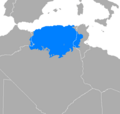Alutor Numerals facts for kids
Quick facts for kids Algerian Arabic |
||||
|---|---|---|---|---|
| Darja, دارجة | ||||
| Native to | Algeria | |||
| Native speakers | 42.5 million (2020)e18 3 million L2 speakers in Algeria (no date) |
|||
| Language family |
Afro-Asiatic
|
|||
| Writing system | Arabic script | |||
 |
||||
|
||||
Algerian Arabic is a type of Arabic language spoken in northern Algeria. People in Algeria often call it Darja. It's part of a group of Arabic languages spoken across North Africa, including Tunisian and Moroccan. Speakers of these languages can often understand each other a little bit.
Like other Arabic languages in this region, Algerian Arabic gets most of its words from ancient Semitic languages. It also has words and influences from Berber and old Latin languages. You'll find many words borrowed from French, Andalusian Arabic, Ottoman Turkish, and Spanish too!
Algerian Arabic is the main language for about 75% to 80% of people in Algeria. Almost everyone, about 85% to 100%, can speak it well. It's the language people use every day for talking, watching movies, and listening to music. However, for official things like school or government, people usually use Modern Standard Arabic.
What is Algerian Arabic?
Algerian Arabic is a special kind of Arabic. It's not exactly the same as the Arabic you might learn in school. Think of it like how American English is different from British English. They are both English, but they have their own unique words and ways of speaking.
This language is mainly spoken in the northern parts of Algeria. It's a living language that changes and grows with the people who speak it.
How is it Different?
Algerian Arabic has a mix of words from many different places. This makes it unique!
- Semitic Roots: Most of its basic words come from the ancient Semitic language family. This is the same family that includes Hebrew and Aramaic.
- Berber Influence: The Berber people lived in North Africa for a very long time. Their languages have added many words and sounds to Algerian Arabic.
- European Words: Because of history, Algerian Arabic has borrowed many words from French and Spanish. You might hear words that sound similar to French or Spanish words!
- Other Arabic Influences: It also has words from Andalusian Arabic (spoken in old Spain) and Ottoman Turkish.
Daily Use of Algerian Arabic
Algerian Arabic is super important for daily life in Algeria. It's the language friends use to chat, families use at home, and artists use in songs and TV shows.
- Everyday Talk: If you visit Algeria, you'll hear Darja everywhere! It's how people communicate in markets, on the street, and with their neighbors.
- Entertainment: Many Algerian movies, TV shows, and songs are in Darja. This helps keep the language alive and fun.
- Official Language: While Darja is for daily life, Modern Standard Arabic (MSA) is used for official things. MSA is the formal version of Arabic used in books, news, and schools across the Arab world. So, Algerians often learn both!
Images for kids


